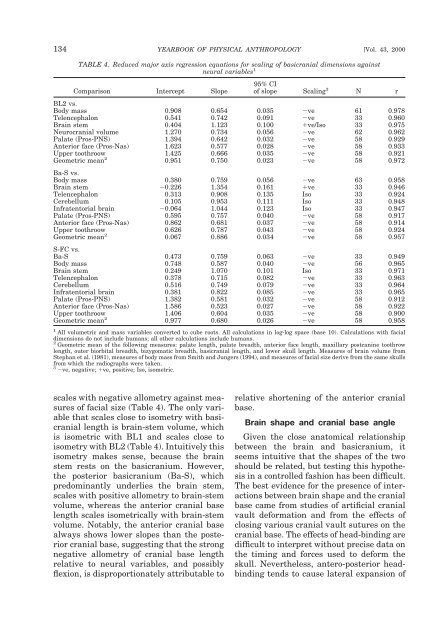The primate cranial base: ontogeny, function and - Harvard University
The primate cranial base: ontogeny, function and - Harvard University
The primate cranial base: ontogeny, function and - Harvard University
Create successful ePaper yourself
Turn your PDF publications into a flip-book with our unique Google optimized e-Paper software.
134 YEARBOOK OF PHYSICAL ANTHROPOLOGY [Vol. 43, 2000<br />
TABLE 4. Reduced major axis regression equations for scaling of basi<strong>cranial</strong> dimensions against<br />
neural variables 1<br />
Comparison Intercept Slope<br />
95% CI<br />
of slope Scaling 3 N r<br />
BL2 vs.<br />
Body mass 0.908 0.654 0.035 ve 61 0.978<br />
Telencephalon 0.541 0.742 0.091 ve 33 0.960<br />
Brain stem 0.404 1.123 0.100 ve/Iso 33 0.975<br />
Neuro<strong>cranial</strong> volume 1.270 0.734 0.056 ve 62 0.962<br />
Palate (Pros-PNS) 1.394 0.642 0.032 ve 58 0.929<br />
Anterior face (Pros-Nas) 1.623 0.577 0.028 ve 58 0.933<br />
Upper toothroow 1.425 0.666 0.035 ve 58 0.921<br />
Geometric mean 2 0.951 0.750 0.023 ve 58 0.972<br />
Ba-S vs.<br />
Body mass 0.380 0.759 0.056 ve 63 0.958<br />
Brain stem 0.226 1.354 0.161 ve 33 0.946<br />
Telencephalon 0.313 0.908 0.135 Iso 33 0.924<br />
Cerebellum 0.105 0.953 0.111 Iso 33 0.948<br />
Infratentorial brain 0.064 1.044 0.123 Iso 33 0.947<br />
Palate (Pros-PNS) 0.595 0.757 0.040 ve 58 0.917<br />
Anterior face (Pros-Nas) 0.862 0.681 0.037 ve 58 0.914<br />
Upper toothroow 0.626 0.787 0.043 ve 58 0.924<br />
Geometric mean 2 0.067 0.886 0.034 ve 58 0.957<br />
S-FC vs.<br />
Ba-S 0.473 0.759 0.063 ve 33 0.949<br />
Body mass 0.748 0.587 0.040 ve 56 0.965<br />
Brain stem 0.249 1.070 0.101 Iso 33 0.971<br />
Telencephalon 0.378 0.715 0.082 ve 33 0.963<br />
Cerebellum 0.516 0.749 0.079 ve 33 0.964<br />
Infratentorial brain 0.381 0.822 0.085 ve 33 0.965<br />
Palate (Pros-PNS) 1.382 0.581 0.032 ve 58 0.912<br />
Anterior face (Pros-Nas) 1.586 0.523 0.027 ve 58 0.922<br />
Upper toothroow 1.406 0.604 0.035 ve 58 0.900<br />
Geometric mean 2 0.977 0.680 0.026 ve 58 0.958<br />
1 All volumetric <strong>and</strong> mass variables converted to cube roots. All calculations in log-log space (<strong>base</strong> 10). Calculations with facial<br />
dimensions do not include humans; all other calculations include humans.<br />
2 Geometric mean of the following measures: palate length, palate breadth, anterior face length, maxillary postcanine toothrow<br />
length, outer biorbital breadth, bizygomatic breadth, basi<strong>cranial</strong> length, <strong>and</strong> lower skull length. Measures of brain volume from<br />
Stephan et al. (1981), measures of body mass from Smith <strong>and</strong> Jungers (1994), <strong>and</strong> measures of facial size derive from the same skulls<br />
from which the radiographs were taken.<br />
3 ve, negative; ve, positive; Iso, isometric.<br />
scales with negative allometry against measures<br />
of facial size (Table 4). <strong>The</strong> only variable<br />
that scales close to isometry with basi<strong>cranial</strong><br />
length is brain-stem volume, which<br />
is isometric with BL1 <strong>and</strong> scales close to<br />
isometry with BL2 (Table 4). Intuitively this<br />
isometry makes sense, because the brain<br />
stem rests on the basicranium. However,<br />
the posterior basicranium (Ba-S), which<br />
predominantly underlies the brain stem,<br />
scales with positive allometry to brain-stem<br />
volume, whereas the anterior <strong>cranial</strong> <strong>base</strong><br />
length scales isometrically with brain-stem<br />
volume. Notably, the anterior <strong>cranial</strong> <strong>base</strong><br />
always shows lower slopes than the posterior<br />
<strong>cranial</strong> <strong>base</strong>, suggesting that the strong<br />
negative allometry of <strong>cranial</strong> <strong>base</strong> length<br />
relative to neural variables, <strong>and</strong> possibly<br />
flexion, is disproportionately attributable to<br />
relative shortening of the anterior <strong>cranial</strong><br />
<strong>base</strong>.<br />
Brain shape <strong>and</strong> <strong>cranial</strong> <strong>base</strong> angle<br />
Given the close anatomical relationship<br />
between the brain <strong>and</strong> basicranium, it<br />
seems intuitive that the shapes of the two<br />
should be related, but testing this hypothesis<br />
in a controlled fashion has been difficult.<br />
<strong>The</strong> best evidence for the presence of interactions<br />
between brain shape <strong>and</strong> the <strong>cranial</strong><br />
<strong>base</strong> came from studies of artificial <strong>cranial</strong><br />
vault deformation <strong>and</strong> from the effects of<br />
closing various <strong>cranial</strong> vault sutures on the<br />
<strong>cranial</strong> <strong>base</strong>. <strong>The</strong> effects of head-binding are<br />
difficult to interpret without precise data on<br />
the timing <strong>and</strong> forces used to deform the<br />
skull. Nevertheless, antero-posterior headbinding<br />
tends to cause lateral expansion of
















